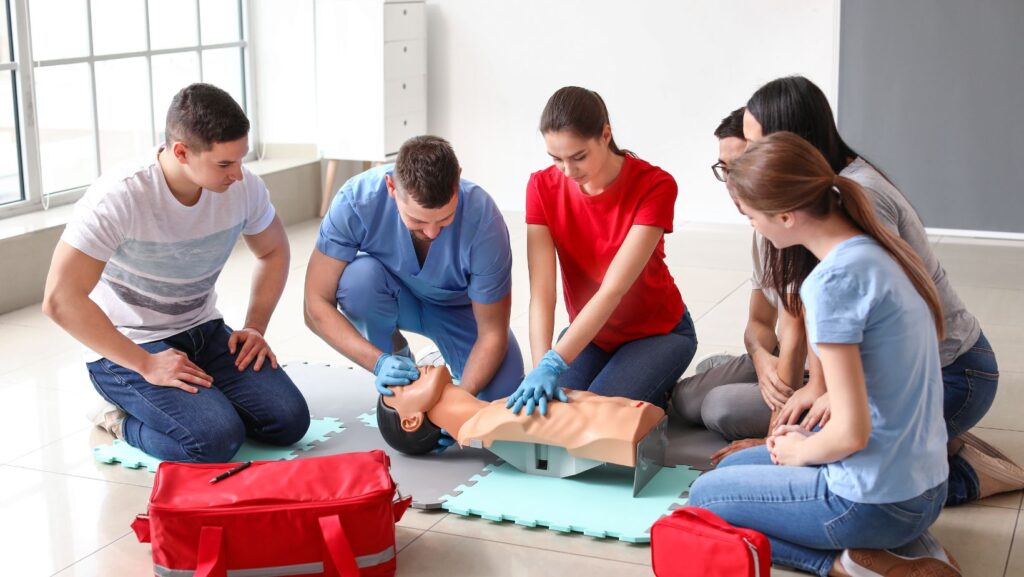
Renew CPR Certification for Warehouse and Industrial Workers
Warehouse and industrial workers perform in dynamic settings where each day deals with heavy and complex machinery, and have to maintain their composure in times of medical emergencies. A sudden cardiac event can probably be the most serious situation these workers can face. So, the presence of Cardiopulmonary Resuscitation (CPR) certified responders on-site is highly essential. It can be achieved with the right CPR certification to help employees become safety-compliant and develop confidence to save lives. It is equally important to renew CPR certification to keep it relevant. OSHA’s 2025 guidelines also stress refresher training that can protect lives and keep industries CPR-ready.
This blog highlights how regular CPR renewal strengthens team readiness, ensures compliance, and unites to keep a safe and prepared workplace.
Why is CPR Certification Needed for Warehouse Safety
Working in a warehouse is full of risks and moments of seconds are constantly put to the test. The warehousing sector, as reported by the U.S. Bureau of Labor Statistics, has higher fatal injury rates, as per their (2023) publication “Injuries, Illnesses, and Fatalities“. This emphasizes the urgent safety needs of having responders trained in CPR and ready on-site due to the following factors:
- Machinery Injuries: Heavy machinery can lead to fatal situations, such as the crushing of the human body. CPR-assisted essential support to the victim can help in recovery and life.
- Electrical Exposure: Workers may face a risk of a sudden shock or even electrocution. CPR training provides the optimal way to react to a cardiac arrest from electrical dangers.
- Physical Stress and Environment: Doing hard work may lead a person to give up due to stress on the heart. At the same time, responders spot such situations and provide CPR assistance.
- Unique Warehouse Risks: Risks related to moving vehicles, hazardous materials, and slips bring an increased possibility of dying. A prompt CPR to the victim can appease the situation.
- Emergency Equipment Readiness: By ensuring the availability of items such as CPR masks, gloves, and AEDs in different departments, the hospital can speed up and deliver safe emergency care.
- Cardiac Survival Advantage: Chances of survival are two times greater if CPR is initiated within 3-4 minutes. The intervention of a trained responder is, therefore, a life-saving act.
CPR Training and Renewal Best Practices for Industries
OSHA’s Training Requirements in OSHA Standards strongly advise employers to put in place a regular training mechanism that would keep the emergency response level at a high and efficient state. Some of the suggested measures are:

- Plan yearly group recertification sessions with trainers authorized by OSHA.
- Implement hybrid CPR training with online learning and in-person practice.
- Include CPR refreshers as part of monthly safety meetings.
- Keep a record of certification renewals through digital means for compliance purposes.
Renewing CPR certification is essential because the ability to execute such skills deteriorates substantially after a short period of time without practice. Moreover, the emergency guidelines change from time to time, and the use of outdated methods can even result in the loss of lives. A renewal will definitely make the industrial teams more aware and confident to take the following actions decisively:
Encourage Semi-Annual Practice Sessions
According to OSHA guidance, CPR skills start to decline between 6 and 12 months after training. Regular semi-annual practice sessions are a way of refreshing one`s memory and maintaining a quick and competent reaction to cardiac emergencies.
Recommend Instructor-Led Annual Revalidation
In a high-hazard team like warehouse workers, OSHA is of the view that the CPR renewal should be a yearly, instructor-led session only, and for first aid retraining, it is every three years. Consequently, the team keeps being alert and confident through the inclusion of simulations and real-life situations.
Provide a Checklist by Employers for Warehouse and Industrial Workers
To align with CPR regulations, it is necessary to figure out the training needed in order to keep the certificate up to date. Plan renewals by grouping teams or group refreshers, and keep an eye on the compliance of contractors. Keep a record to renew CPR certification before the expiry dates by using a digital device, a safe move against lapses. Organize, get ready by holding drills from time to time, and document training for OSHA compliance.
Tips to Build a CPR-Ready Warehouse and Industry Culture
Having a warehouse culture ready for CPR is not only about meeting the OSHA requirements, but with these compliant and functional tips, you can make safety a part of your culture:
- Promote certified responders and carry out an OSHA EAP to increase the level of trust.
- Plan shift rotations, assign safety leaders, and hold refresher drills.
- Make use of CPR renewals to also cover other safety topics, such as ergonomics and hazard labeling, for a holistic safety approach.
Renew CPR, Boost Warehouse Safety!
For your warehouse team to remain self-assured, in line with the law, and ready for emergencies, renew CPR certification. A timely renewal keeps the abilities fresh, promotes the team spirit, and is aligned with OSHA’s refresher training regulations. Additionally, pairing CPR renewal with safety measures elevates workplace security. By enrolling in the CPR Certification for the Construction Industry, you will see how it defines the warehouse emergency response.





